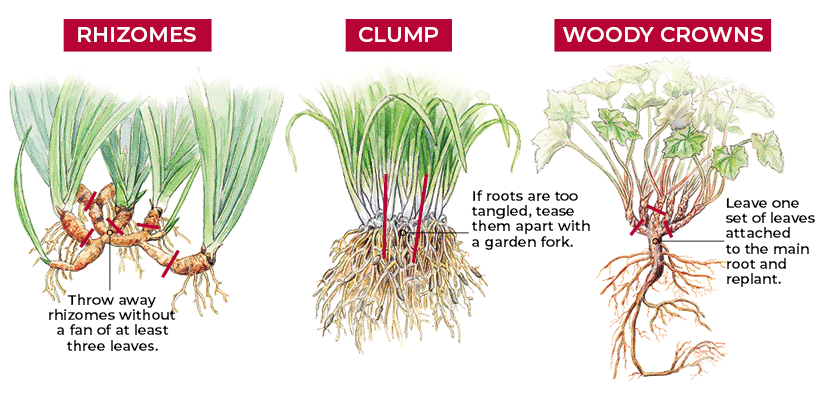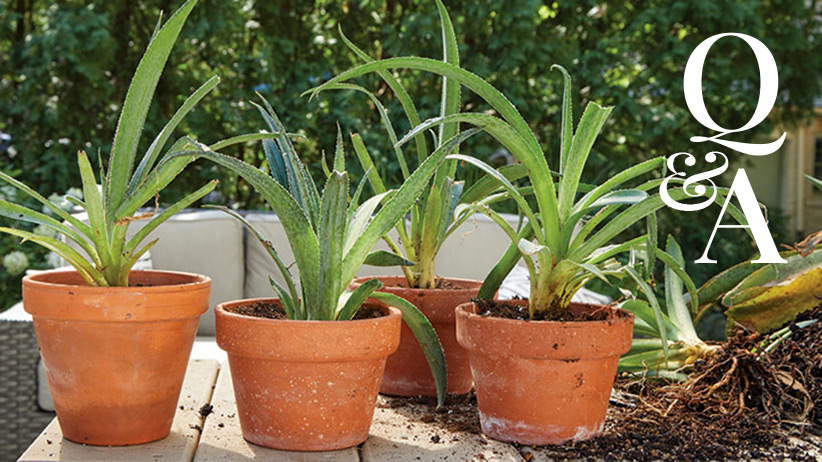Can I divide plants in summer?
While spring and fall are traditionally the best time to divide, there are plenty of reasons you may need to divide a plant in the summer. Whether you’re moving or just haven’t had the time until now, many plants take summer division just fine as long as you follow the tips I’m about to share. There are even some plants, such as bearded iris and Oriental poppies, that are better off being split this time of year.
Signs your plant needs dividing:
- Fewer flowers
- A dead center
- A shrinking plant
You Might Also Like:
Don't Divide These Perennials
Easy Flowers to Grow
How to Water Perennial Plants
3 Simple Ways to Divide Plants
How to divide plants in summer
1. Water beforehand
Water the plant you want to divide and its future home the day before you dig.
2. Cut back foliage
Before digging, cut the foliage back by half: This way a smaller root system won’t have to support lots of foliage in the heat later.
- Shear plants whose leaves go all the way to the base, such as daylilies (Hemerocallis spp. and hybrids), to within a few inches of the soil line.
- But if a plant’s leaves are mostly at the ends of the stems like Coral bells (Heuchera spp. and hybrids), you’ll need to cut individual leaves in half.

3. Dig up the plant & divide
Dig up the plant, slicing 4 to 6 inches out from the edge of the crown. Then you can divide. The red lines above, show you where to split the different root types. See more details on how to divide plants here.
4. Plant quickly
Get your new plant in the hole quickly so the roots don’t dry out. Once the plant is in place, fill the hole halfway with soil and water well. That way the water soaks in and doesn’t evaporate or roll off the soil’s surface.
5. Fertilize
Apply an organic liquid fertilizer, such as Neptune’s Harvest, when you water to help get plants off to a good start.
6. Finish planting
Fill the hole the rest of the way with soil and water it again.
7. Mulch
Apply an inch or two of organic mulch to help conserve water.
Tips for dividing plants in summer
- Full-sun plants will benefit from a shade shelter for a week or two. Insert a few bamboo stakes in the soil and clothespin some landscape fabric to the stakes to make a screen. Position it on the west side of the plant to protect it during the hottest sun of the day.
- Check your plant each day, and if it looks wilted in the morning or late evening, give it a drink of water.
- You may need to water daily for a few days after planting.
Look over the list below and you’ll find a lot of plants that take summer division in stride. Don’t see yours on the list? Some plants don’t like division anytime. Now you know what and how to divide this summer... no sweat!
You Might Also Like:
Long-Lived Perennials for Your Garden
Tips for Adding Structure to Your Garden
How to Divide 45+ Favorite Perennials
Plants you can divide in summer
| Plant name Botanical name | Cold hardiness USDA Zones | Plant size | Root type | Comments & Tips |
|---|---|---|---|---|
| Bearded iris Iris hybrids |
3 to 9 | 8-40 in. tall, 18 in. wide | Rhizome | Needs division every 3 to 4 years in midsummer to remain vigorous; cut leaves back so there’s 4 to 5 in. left above the rhizome |
| Bellflower, clustered Campanula glomerata |
3 to 9 | 15 in.tall, 18 in. wide | Clump | Divide after the first flush of blooms is finished; second, smaller rebloom will be sacrificed |
| Bellflower, spotted Campanula punctata |
4 to 9 | 26 in. tall, spreading | Clump | Spreads quickly; divide frequently to keep it in bounds; provide new divisions with shade |
| Bergenia Bergenia cordifolia |
3 to 9 | 8-24 in. tall, 12-24 in. wide | Clump | Look for fewer flowers or a crowded-looking plant; usually needs division every 4 to 5 years; cut leaves back by half |
| Bugleweed Ajuga reptans |
3 to 9 | 4-6 in. tall, 10-24 in. wide | Clump | Plants root as they spread; no need to dig whole plant; cut off rooted outer pieces and replant |
| Catmint Nepeta x faassenii |
3 to 9 | 12-24 in.tall, 18-36 in. wide | Clump | Doesn’t need division often; cut back whole plant by half so roots have less foliage to support |
| Columbine Aquilegia spp. and hybrids |
3 to 8 | 5-36 in. tall, 6-18 in. wide | Woody | Seedlings don’t always look like parent plant so divide hybrids every few years to keep this short-lived perennial around |
| Coral bells Heuchera hybrids |
3 to 9 | 6-18 in. tall, 10-24 in. wide | Woody | Don’t worry about getting roots with each piece, they’ll sprout from crown; cut individual leaves back by half to conserve moisture |
| Coreopsis Coreopsis grandiflora |
3 to 9 | 18-24 in. tall, 18-24 in. wide | Clump | Division every 3 to 4 years helps this short-lived perennial stay around longer; cut plant back by half |
| Corydalis Corydalis lutea |
5 to 8 | 4-18 in. tall, 6-12 in. wide | Rhizome | Don’t keep new plant too wet after you divide or it will rot |
| Daylily Hemerocallis spp. and hybrids |
3 to 9 | 12-36 in. tall, 9-24 in. wide | Clump | Divide every 5 to 7 years to keep clumps healthy; rebloomers are best lifted in spring before they flower |
| Dianthus Dianthus spp. and hybrids |
3 to 9 | 3-24 in. tall, 8-24 in. wide | Clump | Mat-forming types root as they grow; cut a rooted piece from the edge and replant |
| European wild ginger Asarum europaeum |
5 to 7 | 4-8 in. tall, 9-12 in. wide | Rhizome | Easy to dig and split; likes moist to wet soils, so keep new plants well-watered |
| Fernleaf bleeding heart Dicentra eximia |
3 to 9 | 12-18 in. tall and wide | Clump | Foliage may go dormant after dividing, but don’t worry, the plant will come back next spring |
| Foxtail lily Eremurus stenophyllus |
6 to 9 | 24-36 in. tall, 9-12 in. wide | Woody crown | Roots are brittle so only divide mature plants in midsummer; wait for the leaves to die down for the season |
| Garden phlox Phlox paniculata |
4 to 9 | 1-4 ft. tall, 1-3 ft. wide | Clump | Divide every 3 years or when flowering diminishes; discard the woody center and plant the edge pieces |
| Lamb’s ear Stachys byzantina |
4 to 8 | 6-18 in. tall, spreading | Clump | This hardy plant roots along the stem; cut a piece off the edge and replant; cut leaves back by half; don’t overwater |
| Lily-of-the-valley Convallaria majalis |
3 to 8 | 8-10 in. tall, 12-18 in. wide | Rhizome | Rhizomes pull apart easily; make sure each new division has a leaf and a cluster of roots |
| Maltese cross Lychnis chalcedonica |
3 to 9 | 36-48 in. tall, 18-24 in. wide | Clump | Divide after flowering in midsummer; cut plant back by half; may lose the second bloom |
| Oriental poppy Papaver orientale |
2 to 9 | 18-36 in. tall, 18 in. wide | Woody crown | Divide in midsummer; foliage goes dormant quickly after flowering so mark the plant’s location; keep new transplants watered |
| Perennial geranium Geranium spp. and hybrids |
4 to 9 | 2-4 ft. tall and wide | Woody crown | A ring of foliage around a dead center tells you it’s time to divide; usually every 3 to 4 years is sufficient |
| Peony Paeonia spp. and hybrids |
3 to 8 | 2-4 ft. tall and wide | Clump | New plants will take a few years to flower; set new plants at the same depth or they won’t bloom; keep watered |
| Pulmonaria Pulmonaria hybrids |
3 to 8 | 6-12 in. tall, 15-40 in. wide | Clump | Big leaves wilt easily; cut each leaf back by half and keep summer plants well-watered |
| Snowdrop anemone Anemone sylvestris |
3 to 9 | 12-18 in. tall, 6-12 in. wide | Rhizome | Can spread quickly in well-drained soil but more slowly in clay; cut rhizomes so each plant has one bud |
| Speedwell Veronica hybrids |
4 to 8 | 6-48 in. tall, 15-18 in. wide | Clump | Easy to slice into pieces; make sure to get plenty of roots with each new section |
| Yarrow Achillea spp. and hybrids |
3 to 10 | 24-36 in. tall, 15-18 in. wide | Clump | Divide every 2 to 3 years; cut foliage back by half so roots don’t have as much foliage to support |

















